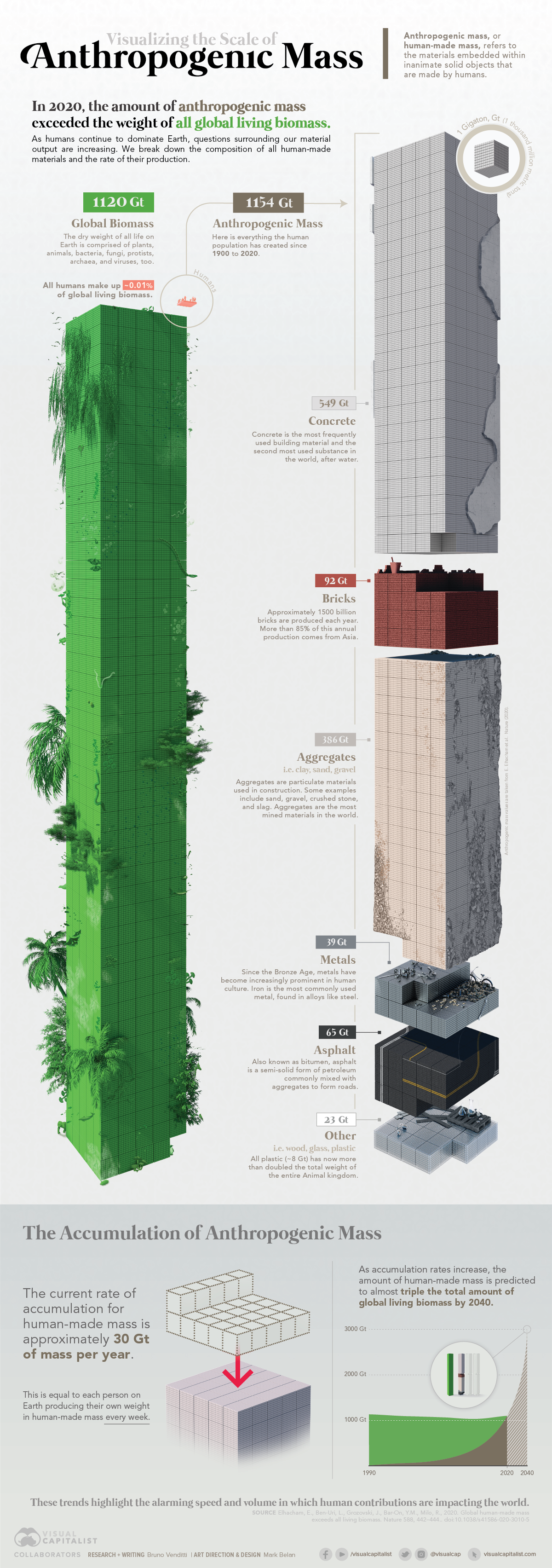visualcapitalist | Anthropogenic mass is defined as the mass embedded in inanimate solid objects made by humans that have not been demolished or taken out of service—which is separately defined as anthropogenic mass waste.
Over the past century or so, human-made mass has increased rapidly, doubling approximately every 20 years. The collective mass of these materials has gone from 3% of the world’s biomass in 1900 to being on par with it today.
While we often overlook the presence of raw materials, they are what make the modern economy possible. To build roads, houses, buildings, printer paper, coffee mugs, computers, and all other human-made things, it requires billions of tons of fossil fuels, metals and minerals, wood, and agricultural products.
Human-Made Mass
Every year, we extract almost 90 billion tons of raw materials from the Earth. A single smartphone, for example, can carry roughly 80% of the stable elements on the periodic table.
The rate of accumulation for anthropogenic mass has now reached 30 gigatons (Gt)—equivalent to 30 billion metric tons—per year, based on the average for the past five years. This corresponds to each person on the globe producing more than his or her body weight in anthropogenic mass every week.
At the top of the list is concrete. Used for building and infrastructure, concrete is the second most used substance in the world, after water.
| Human-Made Mass | Description | 1900 (mass/Gt) | 1940 (mass/Gt) | 1980 (mass/Gt) | 2020 (mass/Gt) |
|---|---|---|---|---|---|
| Concrete | Used for building and infrastructure, including cement, gravel and sand | 2 | 10 | 86 | 549 |
| Aggregates | Gravel and sand, mainly used as bedding for roads and buildings | 17 | 30 | 135 | 386 |
| Bricks | Mostly composed of clay and used for constructions | 11 | 16 | 28 | 92 |
| Asphalt | Bitumen, gravel and sand, used mainly for road construction/pavement | 0 | 1 | 22 | 65 |
| Metals | Mostly iron/steel, aluminum and copper | 1 | 3 | 13 | 39 |
| Other | Solid wood products, paper/paperboard, container and flat glass and plastic | 4 | 6 | 11 | 23 |
Bricks and aggregates like gravel and sand also represent a big part of human-made mass.
Although small compared to other materials in our list, the mass of plastic we’ve made is greater than the overall mass of all terrestrial and marine animals combined.

As the rate of growth of human-made mass continues to accelerate, it could become triple the total amount of global living biomass by 2040.



0 comments:
Post a Comment